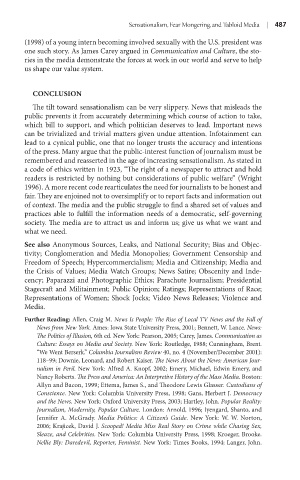Page 508 - Battleground The Media Volume 1 and 2
P. 508
Sensat onal sm, Fear Monger ng, and Tablo d Med a |
(1998) of a young intern becoming involved sexually with the U.S. president was
one such story. As James Carey argued in Communication and Culture, the sto-
ries in the media demonstrate the forces at work in our world and serve to help
us shape our value system.
ConCLusion
The tilt toward sensationalism can be very slippery. News that misleads the
public prevents it from accurately determining which course of action to take,
which bill to support, and which politician deserves to lead. Important news
can be trivialized and trivial matters given undue attention. Infotainment can
lead to a cynical public, one that no longer trusts the accuracy and intentions
of the press. Many argue that the public-interest function of journalism must be
remembered and reasserted in the age of increasing sensationalism. As stated in
a code of ethics written in 1923, “The right of a newspaper to attract and hold
readers is restricted by nothing but considerations of public welfare” (Wright
1996). A more recent code rearticulates the need for journalists to be honest and
fair. They are enjoined not to oversimplify or to report facts and information out
of context. The media and the public struggle to find a shared set of values and
practices able to fulfill the information needs of a democratic, self-governing
society. The media are to attract us and inform us; give us what we want and
what we need.
see also Anonymous Sources, Leaks, and National Security; Bias and Objec-
tivity; Conglomeration and Media Monopolies; Government Censorship and
Freedom of Speech; Hypercommercialism; Media and Citizenship; Media and
the Crisis of Values; Media Watch Groups; News Satire; Obscenity and Inde-
cency; Paparazzi and Photographic Ethics; Parachute Journalism; Presidential
Stagecraft and Militainment; Public Opinion; Ratings; Representations of Race;
Representations of Women; Shock Jocks; Video News Releases; Violence and
Media.
Further reading: Allen, Craig M. News Is People: The Rise of Local TV News and the Fall of
News from New York. Ames: Iowa State University Press, 2001; Bennett, W. Lance. News:
The Politics of Illusion, 6th ed. New York: Pearson, 2005; Carey, James. Communication as
Culture: Essays on Media and Society. New York: Routledge, 1988; Cunningham, Brent.
“We Went Berserk.” Columbia Journalism Review 40, no. 4 (November/December 2001):
118–99; Downie, Leonard, and Robert Kaiser. The News About the News: American Jour-
nalism in Peril. New York: Alfred A. Knopf, 2002; Emery, Michael, Edwin Emery, and
Nancy Roberts. The Press and America: An Interpretive History of the Mass Media. Boston:
Allyn and Bacon, 1999; Ettema, James S., and Theodore Lewis Glasser. Custodians of
Conscience. New York: Columbia University Press, 1998; Gans, Herbert J. Democracy
and the News. New York: Oxford University Press, 2003; Hartley, John. Popular Reality:
Journalism, Modernity, Popular Culture. London: Arnold, 1996; Iyengard, Shanto, and
Jennifer A. McGrady. Media Politics: A Citizen’s Guide. New York: W. W. Norton,
2006; Krajicek, David J. Scooped! Media Miss Real Story on Crime while Chasing Sex,
Sleaze, and Celebrities. New York: Columbia University Press, 1998; Kroeger, Brooke.
Nellie Bly: Daredevil, Reporter, Feminist. New York: Times Books, 1994; Langer, John.

